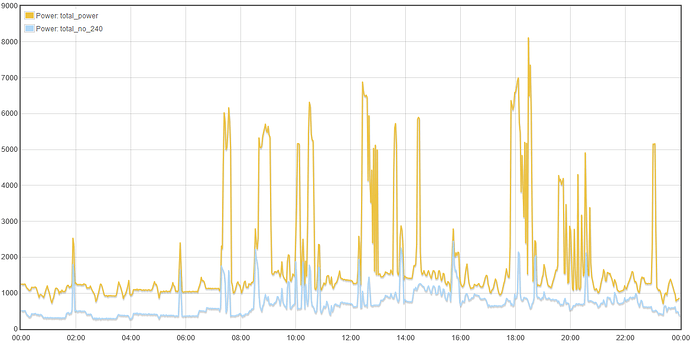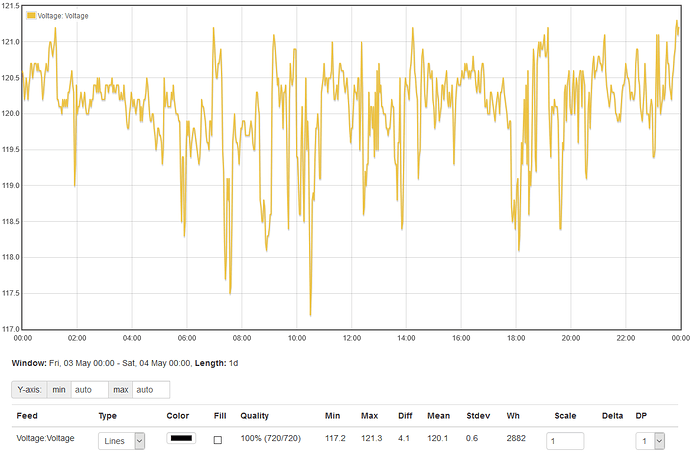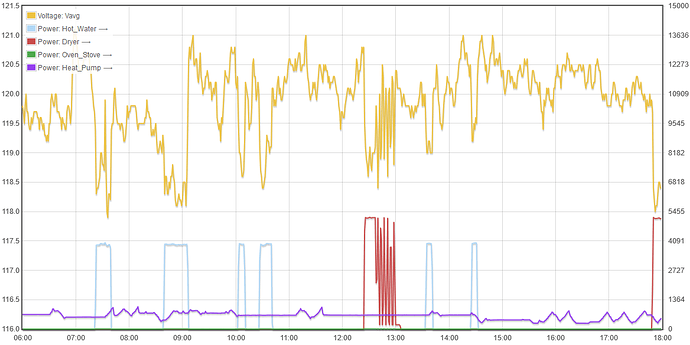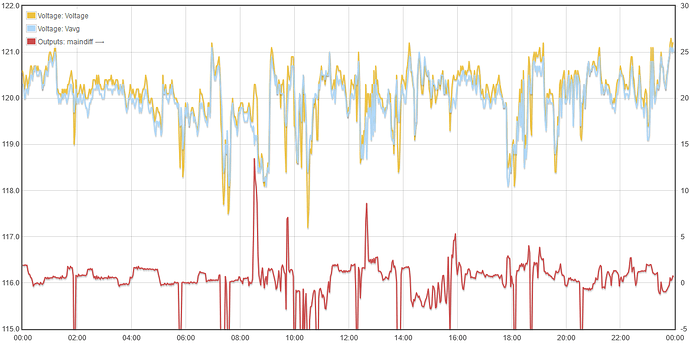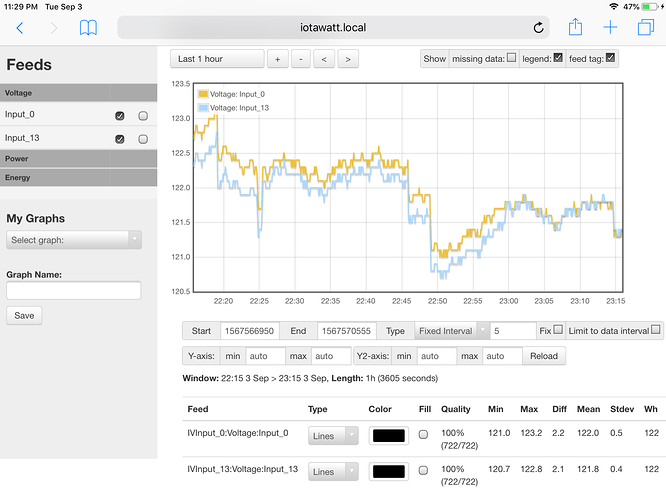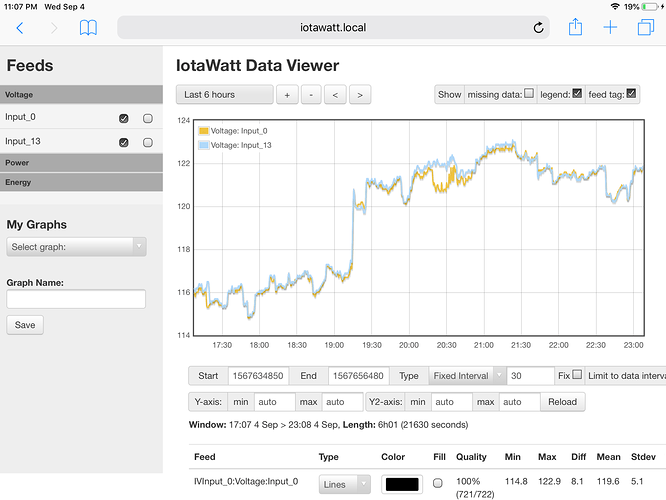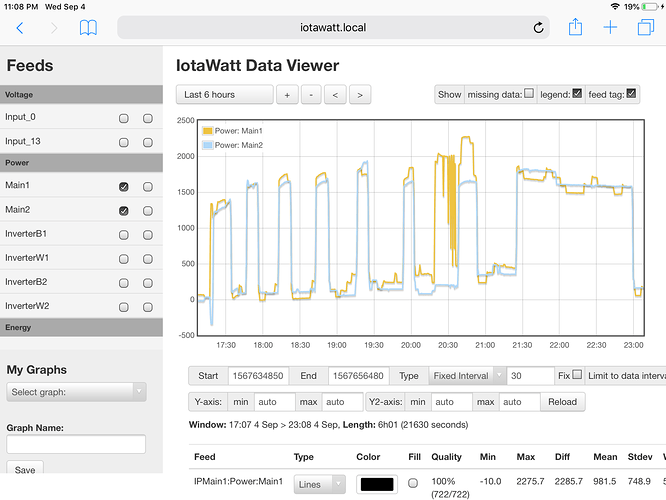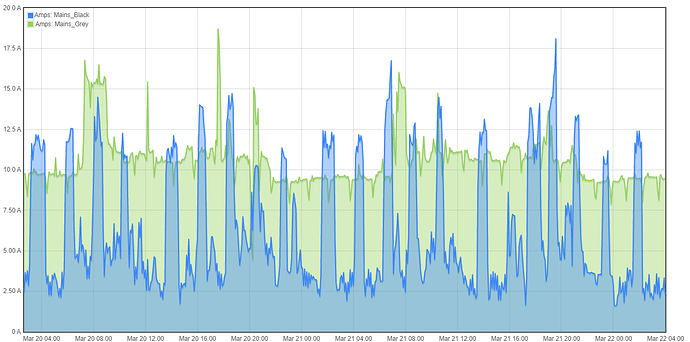I’ve been monitoring my US split-phase service for two years now using a single 120V reference on one “leg” of the service. The results have been excellent, with overall and individual results within 1% of the utility meter and several revenue grade EKM meters on individual circuits. I long ago became comfortable with the notion of the single 120V reference, even though that voltage typically varies between 119V and 121V throughout the day with excursions even further off the mean from time to time.
I’ve measured the other leg, but that didn’t really provide enough data to satisfy my curiosity about the practical effects of some of the conventional wisdom that I’ve read about this. One of the warnings that I hear often is that when a transformer is shared with neighbors, their activity can adversely effect your voltage balance. I share a transformer with 5 other households, so I’m interested in how much stock to place in these warnings.
The US power system as delivered to residences, is not all that different from Europe and the UK. It is basically a 240V single-phase system, albeit with a center tap on the transformer for 120V circuits. We all think of it as a 120V system, because that’s what our light duty appliances and lighting use, and that’s what the wall plugs typically supply, but in reality, homes that use a lot of power typically use most of that power running 240V appliances like water heaters, pumps, clothes dryers, ovens, ranges, and air conditioners.
When those big loads run, they cause the overall voltage to drop at the load-center because of the resistance in the service entrance cables and somewhat because of the internal resistance of the transformer. The portion of the voltage drop caused by the resistance of your service entrance cable:
- Effect only your home.
- Effects both legs equally.
Whatever voltage drop is due to internal resistance of the transformer:
- Effects all of the homes connected to the transformer.
- Effects both legs equally
So all of the 240V loads in the neighborhood will cause a voltage drop that
effects both legs equally.
Here’s my total power for a day, contrasted with the total excluding the heat-pump, hot water, dryer, and oven/stove.
The 240V appliances account for 27kWh out of a total of 44kWh or 61% of the power I used.
But this post is about voltage. Here’s my 120V L1 voltage for the above day (May 3, 2019)
I included the stats line. It says the voltage varied between 117.2 and 121.3 with a mean of 120.1 (pretty good) and a standard deviation of 0.6V. So how appropriate is it to use this voltage to determine power for the L2 leg?
I’ve asserted that the 240V loads effect both legs equally, so awhile ago I added a 240V voltage reference to my IoTaWatt. I just installed a Euro plug and used a standard VT that I sell with the Eurowatt package. With a center tapped transformer, you would expect each leg to be 1/2 the total voltage. So here I’ve plotted 1/2 the total voltage with the L1 voltage:
What we see is that the L1 voltage varies almost perfectly with the overall voltage. Since L1 and L2 always add up to the overall voltage, we know that L2 will therefore also vary almost perfectly with L1 and the overall voltage.
Take a look at how the 240V loads are causing most of the low-voltage dips.
Remember, these 240V loads effect both legs equally.
There is some local variation that can be caused by an imbalance of current drawn between L1 and L2. That variation is caused by a drop in voltage of the high leg because of the resistance of the neutral conductor. This effects both legs equally opposite. That is to say that if one leg drops 0.5V because of a 120V load, the other leg will increase 0.5V. But for all intents and purposes, there is little effect on the per-leg voltage of the neighbors.
To illustrate this, here’s that same day’s voltage plots with most of my 120V loads. You can see clearly that the only place the L1 voltage varies significantly from the overall voltage is when there is a significant 120V load.
So if the 120V loads of my neighbors had any effect on my voltage, I think I would see it here. There is no evidence whatsoever of any significant single leg voltage variation that cannot be attributed to my usage.
For a final perspective, here’s a plot that shown the voltage variation from average along with the current imbalance in Amps between the two legs:
You can see where the imbalance is typically less than a few Amps, but where there is a significant difference, the L1 voltage deviates from the median.
So my conclusion is that with a split-phase US circuit, the loads of neighbors sharing a transformer will not significantly effect power measurements that use the voltage from a single leg as reference.
A secondary conclusion is that rather than use a 120V reference and doubling for 240V sampling, it would be more accurate to use a 240V reference and halve it for 120V sampling, thus splitting the difference for 120V imbalance and being exactly accurate for the dominant 240V loads. Unfortunately, that would be much less convenient for most users.

